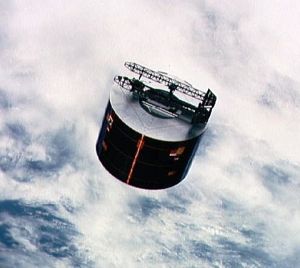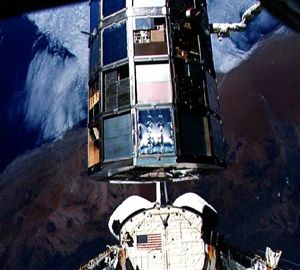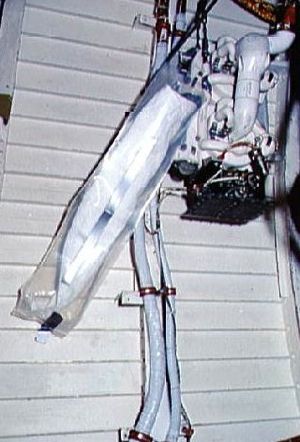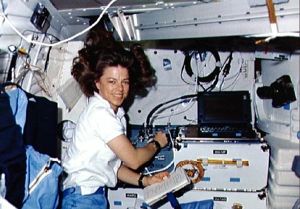
Home - Search - Browse - Alphabetic Index: 0- 1- 2- 3- 4- 5- 6- 7- 8- 9
A- B- C- D- E- F- G- H- I- J- K- L- M- N- O- P- Q- R- S- T- U- V- W- X- Y- Z
STS-32
 STS-32 Air-to-air view of STS-32 Columbia, OV-102, lift-off and SRB separation Credit: NASA |
AKA: Columbia;STS-32R. Launched: 1990-01-09. Returned: 1990-01-20. Number crew: 5 . Duration: 10.88 days.
Payloads: Deployment of Syncom IV-5, retrieval of Long Duration Exposure Facility (LDEF), Fluids Experiment Apparatus (FEA)-3, Protein Crystal Growth (PCG) III-2, Latitude/Longitude Locator (L3), American Flight Echocardiograph (AFE), Characterization of Neurospora Circadian Rhythms in Space (CNCR)-01, Air Force Maui Optical Site (AMOS)-4, Mesoscale Lightning Experiment (MLE), IMAX, Interim Operational Contamination Monitor (IOCM).
Orbits of Earth: 171. Distance traveled: 7,258,096 km. Orbiter Liftoff Mass: 116,116 kg. Orbiter Mass at Landing: 103,569 kg. Payload to Orbit: 12,014 kg. Payload Returned: 9,703 kg. Landed at: Concrete runway 22 at Edwards Air Force Base, California. Landing Speed: 383 kph. Touchdown miss distance: 569 m. Landing Rollout: 3,270 m.
NASA Official Mission Narrative
Mission Name: STS-32 (33)
COLUMBIA (9)
Pad 39-A (37)
33rd Shuttle mission
9th Flight OV-102
3rd Night landing
1st use MLP-3 for Shuttle
Crew:
Daniel C. Brandenstein (3), Commander
James D. Wetherbee (1), Pilot
Bonnie J. Dunbar (2), Mission Specialist 1
G. David Low (1), Mission Specialist 2
Marsha S. Ivins (1), Mission Specialist 3
Milestones:
OPF - Aug. 22, 1989
VAB - Oct. 16,1989
PAD - Nov. 28,1989
Payload:
SYNCOM IV-5,IMAX-03,LDEF
Mission Objectives:
Launch:
January 9,1990,7:35:00 a.m. EST. Launch scheduled for Dec. 18, 1989, postponed to complete and verify modifications to Pad A, being used for first time since January 1986. Launch Jan. 8, 1990 scrubbed due to weather conditions. Launch Weight: 255,994 lbs.
Orbit:
Altitude: 178nm
Inclination: 28.5 degrees
Orbits: 172
Duration: 10 days, 21 hours, 0 minutes, 36 seconds.
Distance: 4,509,972 miles
Hardware:
SRB: BI-035
SRM:360L008
ET : 32/LWT-25
MLP : 3
SSME-1: SN-2024
SSME-2: SN-2022
SSME-3: SN-2028
Landing:
January 20, 1990, 1:35:37 a.m. PST, Runway 22, Edwards Air Force Base, Calif. Rollout distance: 10,731 feet. Rollout time: 62 seconds. Longest Space Shuttle flight to date. Orbiter returned to KSC Jan. 26, 1990. Landing Weight: 228,335 lbs.
Mission Highlights:
Objectives were deployment of SYNCOM IV-F5 defense communications satellite and retrieval of NASA's Long Duration Exposure Facility (LDEF). SYNCOM IV-F5 (also known as LEASAT 5) deployed first, and third stage Minuteman solid perigee kick motor propelled satellite to geosynchronous orbit. LDEF retrieved on flight day four using remote manipulator system. Middeck payloads: Characterization of Neurospora Circadian Rhythms (CNCR); Protein Crystal Growth (PCG); Fluid Experiment Apparatus (FEA); American Flight Echocardiograph (AFE); Latitude /Longitude Locator (L3); Mesoscale Lightning Experiment(MLE); IMAX camera; and Air Force Maui Optical Site (AMOS) experiment.
More at: STS-32.
Family: Manned spaceflight. People: Brandenstein, Dunbar, Ivins, Low, Wetherbee. Country: USA. Spacecraft: Columbia. Projects: STS. Launch Sites: Cape Canaveral. Agency: NASA, NASA Houston.
 | STS-32 Credit: www.spacefacts.de |
 | STS-32 SYNCOM IV-5 satellite drifts over cloud-covered Earth after STS-32 deployment Credit: NASA |
 | STS-32 LDEF Retrieval over the Namib Desert, Namibia, Africa Credit: NASA |
 | STS-32 LDEF positioned by RMS over OV-102's payload during STS-32 retrieval Credit: NASA |
 | STS-32 STS-32 crewmembers, wearing thermal underwear, line up on OV-102's middeck Credit: NASA |
 | STS-32 STS-32 photographic equipment (cameras, lenses, film magazines) on flight deck Credit: NASA |
 | STS-32 STS-32 Mission Specialist Ivins is surrounded by cameras on aft flight deck Credit: NASA |
 | STS-32 STS-32 MS Dunbar with fluids experiment apparatus (FEA) on OV-102's middeck Credit: NASA |
 | STS-32 STS-32 view of the moon setting over the Earth's limb Credit: NASA |
 | STS-32 Christmas Island, Line Island Group, Pacific Ocean Credit: NASA |
 | STS-32 LDEF grappled by remote manipulator system (RMS) during STS-32 retrieval Credit: NASA |
1990 January 9 - .
- STS-32 - Wakeup Song: What's More American? - . Flight: STS-32. "What's More American?" - Words and music by Kadish Millet. Sung by Bing Crosby.
1990 January 9 - . 12:35 GMT - . Launch Site: Cape Canaveral. Launch Complex: Cape Canaveral LC39A. Launch Platform: MLP3. LV Family: Shuttle. Launch Vehicle: Space Shuttle.
- STS-32 - .
Call Sign: Columbia. Crew: Brandenstein,
Dunbar,
Ivins,
Low,
Wetherbee.
Payload: Columbia F09 / Syncom-4 5 [Orbus-7S]. Mass: 12,014 kg (26,486 lb). Nation: USA.
Related Persons: Brandenstein,
Dunbar,
Ivins,
Low,
Wetherbee.
Agency: NASA Houston.
Program: STS.
Class: Manned.
Type: Manned spaceplane. Flight: STS-32.
Spacecraft Bus: Shuttle.
Spacecraft: Columbia.
Duration: 10.88 days. Decay Date: 1990-01-20 . USAF Sat Cat: 20409 . COSPAR: 1990-002A. Apogee: 361 km (224 mi). Perigee: 296 km (183 mi). Inclination: 28.50 deg. Period: 91.10 min.
Manned five crew. Deployed Leasat 5, retrieved LDEF. Night landing. Payloads: Deployment of Syncom IV-5, retrieval of Long Duration Exposure Facility (LDEF), Fluids Experiment Apparatus (FEA)-3, Protein Crystal Growth (PCG) III-2, Latitude/Longitude Locator (L3), American Flight Echocardiograph (AFE), Characterization of Neurospora Circadian Rhythms in Space (CNCR)-01, Air Force Maui Optical Site (AMOS)-4, Mesoscale Lightning Experiment (MLE), IMAX, Interim Operational Contamination Monitor (lOCM).
1990 January 10 - .
- STS-32 - Wakeup Song: The Banana Boat Song - . Flight: STS-32. "The Banana Boat Song" parody kidding G. David Low based on tuneoriginally sung by Harry Belafonte..
1990 January 11 - .
- STS-32 - Wakeup Song: Let It Snow - .
Flight: STS-32.
"Let It Snow" Parody with a message to the crew in the lyrics of"Bring her home" meaning the Long Duration Exposure Facility (LDEF). Written and recorded by"The Prox Ops Boys", Dave Thompson, Mark Schrock, Brian Bertrand, Steve Walker, Ted Rickerl, and Greg Schrage. From the Mission Operations Directorate's Orbit Dynamics (aka Prox Ops) Office
1990 January 12 - .
- STS-32 - Wakeup Song: Hello Dolly - . Flight: STS-32. "Hello Dolly" Parody"Hello LDEF" intended as a tribute to the cargo which was retrieved on 1/12/90. Written and sung by James C. Martin and his friend Terry Radomski. (Martin is the son of Mrs. F. C. Martin, secretary to LDEF Chief Scientist Bill Kinard).
1990 January 13 - .
- STS-32 - Wakeup Song: Attack of the Killer Tomatoes - . Flight: STS-32. "Attack of the Killer Tomatoes" referring to the student (SEEDS) experiment, sending 12.5 million tomato seeds into orbit aboard LDEF..
1990 January 13 - .
- STS-32 - Wakeup Song: Notre Dame Victory March - .
Flight: STS-32.
"Notre Dame Victory March" for pilot Jim Wetherbee, graduate of Notre Dame. Sung by quartet of JSC Mission Operations Directorate personnel, all Notre Dame graduates ( Lead: Mark Ferring, class of '80. Tenor: Chris McKenna, class of '84. Baritone: Pete Hasbrook, class of '85. Bass: Fisher Reynolds, class of '82) CAPCOM: Ken Bowersox
1990 January 14 - .
- STS-32 - Wakeup Song: Bow Down to Washington - . Flight: STS-32. "Bow Down to Washington" , University of Washington's fight song for Mission Specialist Bonnie Dunbar. (from tape with a bunch of fight songs performed by USC band).
1990 January 15 - .
- STS-32 - Wakeup Song: Glory, Glory, Colorado - . Flight: STS-32. "Glory, Glory, Colorado" , the University of Colorado fight song, in honor of Mission Specialist Marsha Ivins..
1990 January 16 - .
- STS-32 - Wakeup Song: Danny Boy - .
Flight: STS-32.
"Danny Boy" - part of a three-part wakeup call in honor of Shuttle Commander Dan Brandenstein's 47th birthday including: a trombone and piano ensemble playing"Danny Boy" performed by Martin and Radomski; Boston Celtics basketball forward Larry Bird offering congratulations to the crew and birthday wishes to Brandenstein; and Astronaut Office personnel singing"Happy Birthday".
1990 January 17 - .
- STS-32 - Wakeup Song: Washington and Lee - . Flight: STS-32. "Washington and Lee" the fight song of Washington and Lee University for David Low..
1990 January 18 - .
- STS-32 - Wakeup Song: Born to Be Wild - . Flight: STS-32. "Born to Be Wild" Steppenwolf.
1990 January 19 - .
- STS-32 - Wakeup Song: Anchor's Aweigh - . Flight: STS-32. "Anchor's Aweigh" for Lt. Commander U.S. Navy Wetherbee; and University of Wisconsin- River Falls' fight song performed by the school's pep band in honor of graduate Brandenstein .
1990 January 20 - .
- Landing of STS-32 - . Return Crew: Brandenstein, Dunbar, Ivins, Low, Wetherbee. Nation: USA. Related Persons: Brandenstein, Dunbar, Ivins, Low, Wetherbee. Program: STS. Flight: STS-32. STS-32 landed at 09:43 GMT. .
Back to top of page
Home - Search - Browse - Alphabetic Index: 0- 1- 2- 3- 4- 5- 6- 7- 8- 9
A- B- C- D- E- F- G- H- I- J- K- L- M- N- O- P- Q- R- S- T- U- V- W- X- Y- Z
© 1997-2019 Mark Wade - Contact
© / Conditions for Use